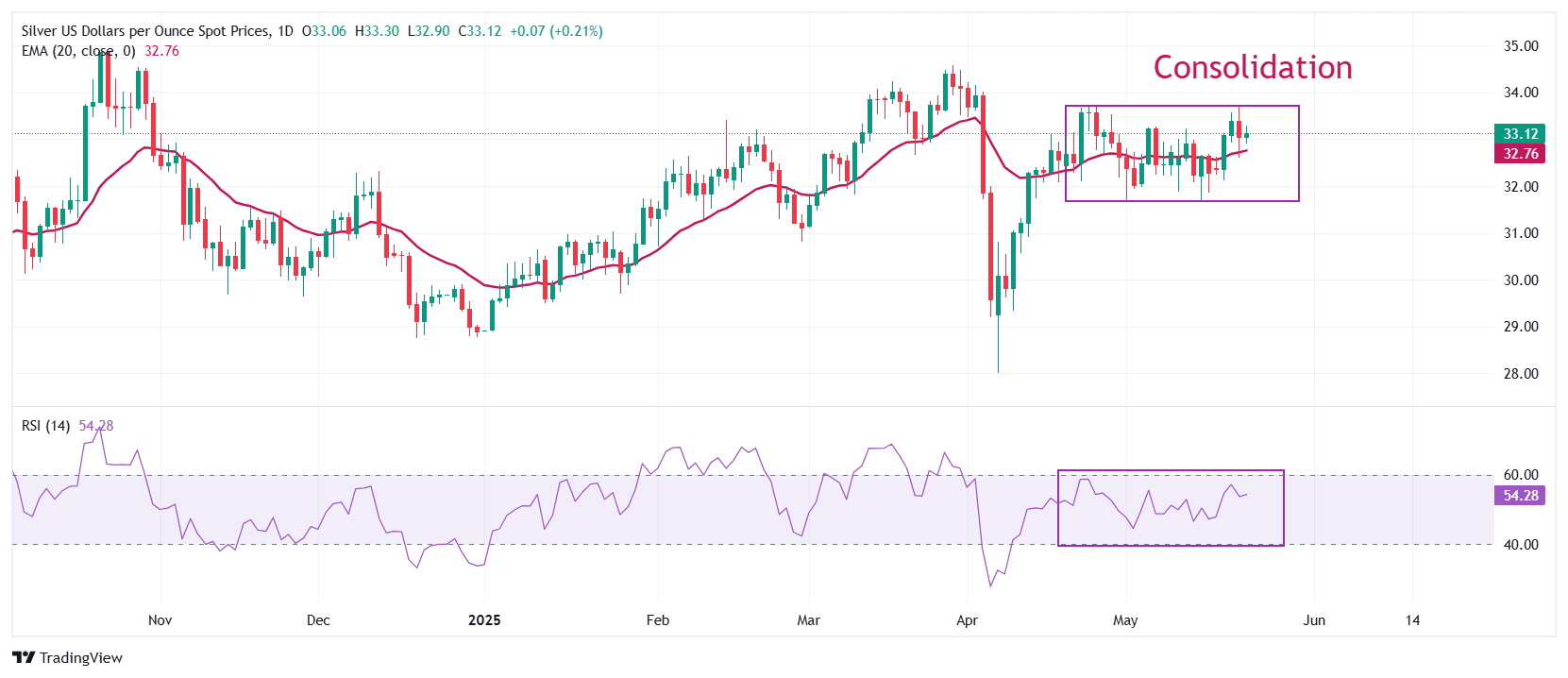- Silver price oscillates inside Thursday’s range around $33.00 despite significant weakness in the US Dollar.
- Heightened concerns over US fiscal imbalances have kept the US Dollar on the backfoot.
- A fresh escalation in the US-EU trade tensions is expected to support the Silver price.
Silver price (XAG/USD) wobbles in a tight range around $33.00 during North American trading hours on Friday. The white metal remains almost flat despite a substantial weakness in the US Dollar (USD). The US Dollar Index (DXY), which gauges the Greenback’s value against six major currencies, refreshes an over three-week low around 99.10.
Technically, a lower US Dollar makes the Silver price a value bet for investors.
The US Dollar continues to suffer from increasing concerns over the United States (US) fiscal imbalances in the wake of President Donald Trump’s tax-cut and spending bill, which has been advanced to the Senate after being approved by the House of Representatives.
According to the nonpartisan Congressional Budget Office, Trump’s new bill would increase the US debt by $3.8 trillion over the decade, which is currently $36.2 trillion. Such a scenario would further damage the US Sovereign credit rating, which was already downgraded by Moody’s to Aa1 from Aaa last week.
Meanwhile, a fresh escalation in trade tensions between the US and the European Union (EU) is expected to support the Silver price. Theoretically, the demand for safe-haven assets, such as Silver, increases when global economic tensions escalate.
During early North American trading hours, US President Trump threatened to impose 50% flat tariffs on the EU in a post on Truth.Social. Our discussions with them are going nowhere! Therefore, I am recommending a straight 50% tariff on the European Union, starting on June 1, 2025. There is no tariff if the product is built or manufactured in the United States. Thank you for your attention to this matter!”, Trump said
Silver technical analysis
Silver price oscillates inside Thursday’s trading range around $33.00 on Friday. The white metal trades in a range between $31.65 and $33.70 for a month. The near-term trend of the white metal is uncertain as it wobbles around the 20-period Exponential Moving Average (EMA), which trades near $32.75.
The 14-period Relative Strength Index (RSI) oscillates inside the 40.00-60.00 range, indicating a sideways trend.
Looking up, the March 28 high of $34.60 will act as key resistance for the metal. On the downside, the April 11 low of $30.90 will be the key support zone.
Silver daily chart

Silver FAQs
Silver is a precious metal highly traded among investors. It has been historically used as a store of value and a medium of exchange. Although less popular than Gold, traders may turn to Silver to diversify their investment portfolio, for its intrinsic value or as a potential hedge during high-inflation periods. Investors can buy physical Silver, in coins or in bars, or trade it through vehicles such as Exchange Traded Funds, which track its price on international markets.
Silver prices can move due to a wide range of factors. Geopolitical instability or fears of a deep recession can make Silver price escalate due to its safe-haven status, although to a lesser extent than Gold’s. As a yieldless asset, Silver tends to rise with lower interest rates. Its moves also depend on how the US Dollar (USD) behaves as the asset is priced in dollars (XAG/USD). A strong Dollar tends to keep the price of Silver at bay, whereas a weaker Dollar is likely to propel prices up. Other factors such as investment demand, mining supply – Silver is much more abundant than Gold – and recycling rates can also affect prices.
Silver is widely used in industry, particularly in sectors such as electronics or solar energy, as it has one of the highest electric conductivity of all metals – more than Copper and Gold. A surge in demand can increase prices, while a decline tends to lower them. Dynamics in the US, Chinese and Indian economies can also contribute to price swings: for the US and particularly China, their big industrial sectors use Silver in various processes; in India, consumers’ demand for the precious metal for jewellery also plays a key role in setting prices.
Silver prices tend to follow Gold’s moves. When Gold prices rise, Silver typically follows suit, as their status as safe-haven assets is similar. The Gold/Silver ratio, which shows the number of ounces of Silver needed to equal the value of one ounce of Gold, may help to determine the relative valuation between both metals. Some investors may consider a high ratio as an indicator that Silver is undervalued, or Gold is overvalued. On the contrary, a low ratio might suggest that Gold is undervalued relative to Silver.

